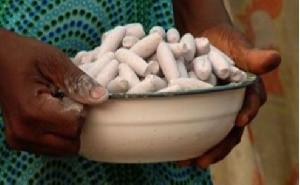Pregnant women who resort to eating 'ayilo' (baked clay) have been warned against the practice because it has serious implications for their health.
A specialist dietician at the Tafo Government Hospital, Mr Daniel Ansah-Obese, who issued the warning, said eating clay can cause anaemia, infertility, lead poisoning, low bone mineralisation, dental injury and organ failure.
According to him, eating clay could cause mental retardation and death of unborn babies.
The nutritional deficiency mothers often suffer as a result of this addiction tends to weaken babies in the womb, and might invariably end their lives in the process.
In an Interview with The Finder, Mr Ansah-Obese said the craving for clay is sometimes caused by nutrient imbalances such as lack of certain nutrients like zinc and iron.
According to him, the situation can be combated by prescribing mineral supplements to complement the nutrient needs of affected pregnant women.
He emphasised the importance of antenatal care, which he said would allow for early detection of these deficiencies, so proactive measures can be taken to shield prospective mothers from the negative repercussions they bring.
He added that eating clay has life-threatening effects, and encouraged people struggling with the habit that “even if the practice started from infancy, with the appropriate help, the addiction can be broken.”
Why you should not be eating clay
1. No nutrients
There is no nutritional value in eating clay. It doesn’t provide the much-needed nutrients for mother and child, and is a health risk to all who consume it. Seriously, you’re basically filling your body with material that gives you nothing in return.
2. Malnutrition
Pregnant women who eat clay are likely to cause malnutrition in their unborn children. This puts the baby’s life at risk and could result in premature birthing and underdeveloped children when they are born.
Young people who consume clay also stand the risk of malnutrition due to their tendency to depend on the substance as a substitute for actual food. Clay-eating is closely related to causing anorexia in young people for this reason.
3. Anaemia
“Ayilo” is freshly dug clay from the ground, which is baked to give it a strong smell. Eggs of worms are usually present in the clay, which, when ingested, hatch and feed on the red blood cells of the body. This leads to most pregnant women recording low haemoglobin levels in the blood, a condition most often attributed to anaemia.
This is also worrisome for young people. Young women, especially, carry the burden of losing blood each month through menstruation, and this, coupled with the severe anaemia the clay addict suffers, could very well be life-threatening.
4. Mental retardation
Recent studies show that mothers who consume excess amounts of clay during pregnancy could be endangering the mental health of their children. Children born in this state are more likely to suffer developmental challenges, in both growth and mental health.
5. Lead poisoning
This one might need a bit more explaining.
Clay contains trace amounts of lead. Lead is a metal commonly found in clay, which bonds with other metals and the bonds lead make with other metals are not easily broken by the digestive process. This causes lead that is ingested to be accumulated over a long period, a process that is life-threatening.
This results in lead poisoning, a condition often characterised by high blood pressure, abdominal pain, constipation, joint pains, muscle pain, decline in mental functioning, headache, memory loss, mood disorders, reduced sperm count, abnormal sperm, miscarriage or premature birth in pregnant women.
6. Dental injury
Consuming excessive amounts of clay might actually cause you to lose your teeth! There are great amounts of trace metals like calcium in clay, which are not necessarily good for your teeth. Here, one might experience sensitivity and brittleness of the tooth, and weakening of the gum. So, if your teeth don’t feel right after you have a few balls of “ayilo”, it might be a sign you need to reconsider your diet.
7. Infertility
Studies have proven that excessive clay-eating could result in huge amounts of clay forming over the womb, making it difficult for conception and child birth. This is potentially fatal for the woman, because these clay deposits have to be surgically removed from the womb.
8. Low bone mineralisation
Your bones need a constant supply of minerals to work. These minerals strengthen your bones and manage your entire skeletal frame. However, clay-eating makes it difficult to maintain required levels of these minerals -- phosphate, calcium, and Vitamin D -- in your body, which results in weakened, brittle bones.
9. Organ failure
Ingesting clay has the propensity to weaken your internal system. Organs such the kidney and the liver are at risk because of the high levels of lead and cadmium and other types of heavy metals found in the environment are often found in clay.
Cadmium exposure is associated with kidney dysfunction, respiratory problems and bone disease—and is also being studied as a potential “carcinogen”, that is, a cancer-causing agent.
10. Death
Few studies indicate that babies of clay-eating mothers are likely to be stillborn.
Mothers, you eating clay like your life depends on it, will eventually lead to your baby’s death being a result of it.
Pica and Geophagy
Clay-eating is a habit that has existed for centuries. Scientists, over the period, have attributed this clay-eating urge to a disorder known only as “Pica.”
The American Psychiatric Association defines pica as the persistent eating of non-nutritive substances that is inappropriate to developmental level, occurs outside culturally sanctioned practice and, if observed during the course of another mental disorder, is sufficiently severe to warrant independent attention.
This is when people with the disorder compulsively eat items that have no nutritional value.
An affected person might eat relatively harmless items, such as ice. Or they might eat potentially dangerous items, like flakes of dried paint or pieces of metal, clay, soap, baby powder, the list goes on.
The geographical placement of a person might be a contributing factor to the likelihood of one consuming these non-nutrient products.
This is termed as “geophagia”
Geophagia refers to the habit of eating earth, soil or clay and is not uncommon in southern parts of the United States as well as urban Africa.
Particularly in Ghana, clay is baked into egg-shaped balls called “Ayilo”, which are then sold on the local market for all to patronise.
Why people eat clay
Where poverty and famine are concerned, earth may serve as an appetite suppressant and filler. In Haiti, clay is oft used as a substitute for flour, and clay cookies are baked with some butter, sugar or salt for human consumption.
Similarly, geophagia has been seen in anorexia nervosa. People have been known to substitute clay with food, in a bid to lose weight.
However, geophagia is often observed in the absence of hunger, and environmental and cultural contexts of the habit have been underlined as a cause.
There is reason to believe that geophagia often goes unrecognised by doctors because patients are reluctant to volunteer the information needed.
Undeniably, stigma plays a role in concealing this behaviour and most people make it a priority to hide this from society.
Many people who indulge in this clay-eating practice would not admit to it, even in the direst of circumstances, as it is viewed by some as disgusting and shameful.
To this, Daniel Ansah-Obese noted that while it is not always easy to identify this disorder in a patient, it is the responsibility of the doctor to look out for his patient’s welfare.
He advised that health personnel be attentive to the mannerisms and habits of the patient, so these problems can be picked up at the early stages and addressed, before they become fatal.
Why pregnant women?
Pregnancy is a phase of both increased nutritional needs and increased defencelessness. In the first trimester, the foetus is particularly vulnerable to contamination.
The pregnant mother is also vulnerable due to a compromised immune system suppressed during pregnancies in order to adapt to the existence of the foetus.
Nutrition during pregnancy is increasingly demanding, especially with regard to minerals such as iron and calcium, in order to support both the growing foetus and elevated blood production. Further, this period of nutritional need coincides with digestive difficulties such as nausea (morning sickness) and vomiting.
Another common attribute of pregnancy is pronounced cravings.
Mr Ansah-Obese said these cravings are as a result of hormonal changes experienced during pregnancy.
He mentioned that women often consume “ayilo” during pregnancy because it is purported to relieve them from discomfort and manage nausea and diarrhoea.
He added that this is predominant in the African society, and because of the availability of the clay matter, it quickly becomes an addiction that seems impossible to break.
It is important to note that while pregnant women are the most frequent consumers of this product, young people and children also eat “Ayilo”, and in large amounts.
He highlighted the negative effects of consuming clay, and said in relation to the benefits clay-consumption might have, the negative implications far outweigh the good.
Mr Ansah-Obese mentioned that while there is no proven medicine for curing a clay-eating addiction, education and counselling might yield positive results toward breaking the addiction.
Family support is also important in curbing this practice, he said. Because this habit is facilitated by pronounced cravings, the pregnant women often have little control where resistance is involved.
He stated that having a strong family support system that one is accountable to will help to monitor and stop this practice.
He, however, cautioned people struggling with this condition to see a dietician, nutritionist and psychologist, so they can curb the addiction both mentally and nutritionally.
In conclusion, it is clear there is not much education regarding the ill-effects of this practice in our various societies. This is partly to blame for the ignorant consumption of “ayilo”. Therefore, we need to intensify our efforts in educating and raising awareness to fight this menace.
If these problems are observed and tackled appropriately, the country would move towards making more progress in achieving its maternal health goals.













